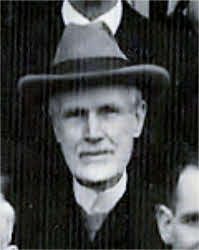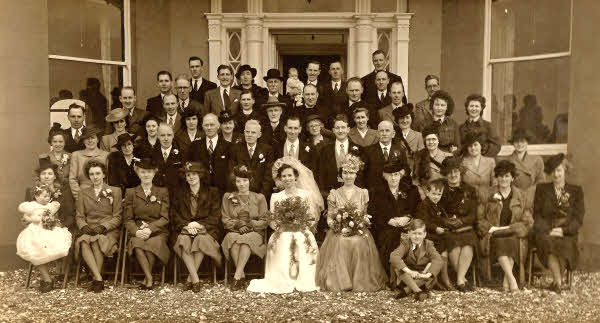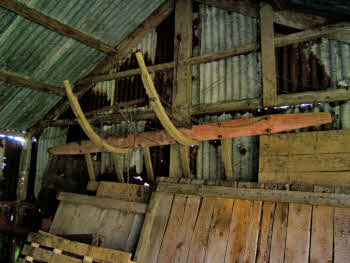
“He used his gifts to help his fellow man”
William Calwell 30th July 1863 – 30th July 1953
THE DIGGER
I had reason to go and visit my maternal grandparents former homestead at Crew, Glenavy a number of years ago with my mother. The farmstead, which had been in the family for generations, had been abandoned in the 1960’s and sold to a neighbouring farmer.
We visited the derelict cottage and outbuildings and my mother recalled happy memories of her childhood as she passed from room to room in her former homestead. We wandered into the old barn and I noticed a strange farming implement hanging on the side of the barn wall. My mother informed me it was the “tumbling paddy” once used by my grandfather in the fields in the immediate vicinity of the farm. This was a hay collector that was harnessed to the horse. The wooden prongs gathered up every last bit of hay that was in the field. When the collector was full a chain mechanism was operated by the farmer and the hay would tumble from the rake into a mound.
I had mentioned my discovery to another local man and former neighbour of my grandfather. He recalled that there was a similar implement used in a bygone time which was referred to as the “Calwell” hay collector, invented by a man who he believed was linked to the Ballinderry area of Lisburn.
The Tumbling Paddy, Paddy or Tumbling Tam, as it was known in Scotland, was an integral part of the machinery found on farmsteads. Amongst the advertisement pages of local newspapers in the early 20th century period you will find numerous notices relating to sales and auctions of property when a local farmer had decided to sell up, call it a day, or died. It was common to find the” Paddy” amongst lists of valued farm machinery including mowing machines, carts, harness, drill ploughs, grubbers, chill ploughs, harrows, rollers and turnip pulpers. In 1900, records show that a tumbling paddy that once belonged to a deceased farmer who resided in the townland of Ballyvollen was valued at £15.
After some research I discovered that in fact a William Calwell, carpenter, residing at Hopecroft, Glenavy in 1903 had submitted a provisional specification application to the patent office for “ improvements in hay collectors.” Applications to the Patent Office were submitted by William Calwell for further improvements to the hay collector on the 28th July, 1916. He also submitted an application for an improved means for driving manure spreaders, hay-makers, thistle-cutters, crop sprayers or grain sowers from the wheels of carts or other vehicles in 1904. At the time of this application William Calwell listed his address as Whitehead. In 1906 he submitted an application suggesting improvements in the design specification. At this time he was listed at Whitehead, but temporarily of San Mateo City, San Mateo, California U.S.A. In 1908 he submitted provisional specifications for improvements in rick-shifting machines. The following year William Calwell, residing at Ballycarry, and Arthur Gregg, timber merchant, Exchange Street, Belfast submitted a joint application for improvements connected with vehicles for shifting or removing ricks of hay. Arthur Gregg, residing at Knockbreda Park, Belfast in the early 20th century was a timber merchant. His father William, an iron merchant, from Willowbank, Antrim Road, Belfast had business premises at Gregg’s Quay, Queen’s Bridge, Belfast and he had traded at 15 – 17 Church Lane, Belfast as William Gregg & Son, Phenix Union Foundry, Belfast.
The official obituaries in the local newspapers in 1953 record that William went to America c1881 where he was a successful builder and architect, returning to Ballycarry in 1910. He served his apprenticeship with his uncle Robert Wisnom who resided in San Mateo, Claifornia. Robert and his wife, Sarah, nee Donnan originated from the Ballycarry area.
There is a record of the marriage of William Calwell, son of David Calwell, farmer, Upper Ballinderry to Mary Higgins at Moira Presbyterian Church on 29th November 1895. David Calwell, spelt Caldwell, and Agnes Wisnom, both from Broadisland were married on 2nd February, 1863 at Ballycarry. They relocated to Woodbrook, Drumnaduff townland, Ballinderry, County Antrim where their family attended the local school at Legaterriff (Public Record Office Northern Ireland - SCH 503 refers). The family farm was left to their son James Alexander after the death of David Caldwell on the 15th August 1906. David and Agnes are buried together in the family grave, located at Ballinderry Presbyterian Church. The headstone indicates that Agnes died on the 8th April, 1927 aged 84 years, a daughter Margaret died 11th April, 1906 aged 26 years and a son Hugh died on 7th January 1885 aged 2 years.
James Alexander Caldwell, born 16th August 1876, married Sarah Elizabeth McKnight on 21st September 1904 at Magheragall Presbyterian Church, Lisburn. The McKnight family resided in the townland of Kilcreeny, Upper Ballinderry. A headstone located in the graveyard at Templecorran, Ballycarry states that Sarah passed away on the 3rd March, 1934 and James on the 5th May, 1963.
Early 20th century records available online at Ellis Island ( https://www.ellisisland.org ) show that William and family members had been travelling between Liverpool and the U.S.A. The arrival of William, his wife and eldest child Bonita, then aged about 2 years of age, are recorded as having travelled on the famous White Star Line ship Oceanic from Liverpool in August 1900. The 1911 Irish census records reveal that their daughter Bonita had been born in California, U.S.A.
On the 10th December 1902 their daughter Avy was born at Glenavy and William registered her birth with Dr. Arthur Mussen, registrar on 9th February 1903. They also had a third daughter, Nancy, born c 1907.

William Calwell
William Calwell is also credited with the introduction of Friesian cattle into Ireland. He had discovered them whilst in California and he believed that they would be well suited to his homeland. After a struggle with bureaucracy the successful importation of Friesian cattle into Ireland took place. He also founded the Co-operative Dairy in Ballycarry in 1910.
He passed away at The Bungalow, Ballycarry on the 30th July, 1953 which was his 90th birthday. He was laid to rest in Templecorran, Ballycarry on Saturday 1st August 1953. His death was registered by his daughter Avy. In his will he left sums of money to the representatives of his father’s church – Ballycarry Presbyterian, his mother’s church – Ballycarry Unitarian and his wife’s church – the Roman Catholic Church, Whitehead. His wife May had predeceased him on the 29th January, 1934. The inscription dedicated to her on the headstone at Templecorran reads - “A sweet, devoted, selfless life.”
Their daughter Avy married James Thomson Dowlin, a widower, gentleman on 22nd March 1938. She later produced a publication in 1963 titled “Ballycarry in Olden Days.” In this publication she published the Ballycarry Song composed by her late father. He was also a renowned poet and balladeer. Other well-known compositions attributed to him include Ballycarry Men and Ballycarry Old Church Walls.
Bonita married into the Wisnom family, and Nancy married Roy Smyley Sproule. Nancy passed away on the 17th June 1969 and she is laid to rest in the graveyard at Templecorran, Ballycarry.
Descendants of the wider Calwell/Caldwell family still reside in the Ballycarry area. An old friend of mine, George Evans Caldwell who resided in the area of The Crew, Glenavy recalled to me many happy memories of his visits to the Calwell homestead at Bellahill, Ballycarry. As a child he travelled into Belfast on a pony and trap and met up with his uncle, Samuel Caldwell who was a dentist at 126 Great Victoria Street, Belfast. Samuel took young George out to Bellahill. He recalls with great fondness participating in the hymn singing on Sunday nights when all the family gathered round the piano at Bellahill. He remarked “As long as I have a memory, I praise the Lord that I can remember that….They touched me with those hymns they sang. It still lives with me and has lived with me all these years – the blessing that I got at that time.”
Thanks to George for assisting with background information relating to the Calwell/Caldwell family and for providing me with copies of photographs from a personal collection.
Thanks also to the Statue of Liberty-Ellis Island Foundation, Inc. for permission to use information obtained on their website www.ellisisland.org
References:
Details of patents can be found at Espacenet
https://www.epo.org/searching/free/espacenet.html
Further reading on Templecorran graveyard, Ballycarry can be found at www.historyfromheadstones.com
Further reading on William Calwell can be found in
* “Memories from the Farmyard” by Paul Callaghan (ISBN 978-1-906578-63-3)
* “Ballycarry in Olden Days” by Amy Dowlin
* Belfast News-Letter, Saturday, August 1st 1953 – Obituary, William Calwell
* Ballycarry – Voices from the Past. Souvenir Booklet produced by Ballycarry Community Association February 1992.
* Belfast News-Letter Saturday, November 4th 2000 – Article by Paul Callaghan – “British Friesians at Stormont”
* Belfast News-Letter Saturday, May 11th 2002 – Article by Paul Callaghan – “British Friesians arrive in Northern Ireland.”
06/06/2012


